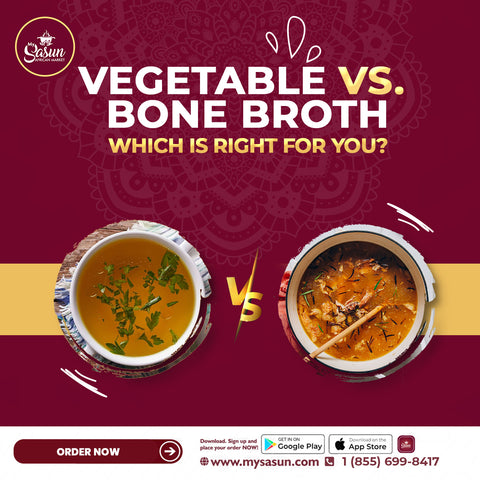Broths have been a staple in kitchens around the world for centuries, including in African traditions. The comforting warmth of a vegetable broth and the rich, hearty flavor of bone broth, are at the heart of many beloved dishes from Africa. But which one is right for you? Let’s dive into the differences, benefits, and cultural significance of both to help you decide.
Also Read: 7 INNOVATIVE WAYS TO USE MY SASUN HOT SPICY BLEND
What Is Vegetable Broth?

Vegetable broth is a savory liquid made by simmering a variety of vegetables, herbs, and spices in water. Common ingredients include onions, garlic, carrots, celery, and leafy greens like spinach or kale. This broth is often used as a base for soups, stews, and sauces- and they provide a light, fresh flavor.
Health Benefits of Vegetable Broth:
- Low in Calories: Vegetable broth is naturally low in calories and this makes it an excellent choice if you’re watching your weight or looking for a light, nutritious option.
- Rich in Vitamins and Minerals: Since it’s made from a variety of vegetables, this broth is packed with essential nutrients like vitamin A, vitamin C, potassium, and magnesium, all of which support your overall health.
- Hydration: The high water content in vegetable broth helps keep you hydrated, especially when consumed as part of a balanced diet.
- Easily Digestible: Vegetable broth is gentle on the stomach and this makes it a great option if you’re recovering from an illness or just need something light.

In traditional West African cuisine, meat or fish stock is typically used as the base for soups like Ogbono and Egusi to create a rich, savory flavor. However, for those following a vegetarian or vegan diet, vegetable broth can be a good alternative. While it offers a lighter flavor compared to the traditional stock, it can still add depth and enhance the overall taste of the dish.
Also Read: 4 Unique Noodle Recipes you should try
What Is Bone Broth?
Bone broth is a nutrient-dense liquid made by simmering animal bones (such as beef, chicken, or fish) along with vegetables, herbs, and spices for several hours. This slow-cooking process extracts collagen, minerals, and other nutrients from the bones and this results in a rich, flavorful broth.
Health Benefits of Bone Broth:
- High in Protein and Collagen: Bone broth is rich in collagen, which supports joint health, skin elasticity, and digestive health. It’s also a good source of protein, which is essential for muscle repair and growth.
- Packed with Minerals: The long simmering process extracts calcium, magnesium, phosphorus, and other essential minerals from the bones, which are crucial for bone health and overall wellness.
- Gut Health: The gelatin in bone broth helps support gut health by repairing the lining of the digestive tract, making it beneficial for those with digestive issues.
- Immune Support: Bone broth is often consumed to help boost the immune system, especially during cold and flu season, due to its nutrient density and warmth.

Bone broth is deeply rooted in West African cooking. In soups like Pepper Soup and Banga Soup, bone broth provides a rich, deep flavor that complements the spices and ingredients used. The slow simmering of bones releases nutrients that make them not only delicious but also nourishing.
In many West African cultures, bone broth is also valued for its healing properties. It’s commonly used as a home remedy for colds, as the warm, nutrient-dense broth is believed to help fight infections, soothe sore throats, and boost the immune system. After childbirth, bone broth is often given to new mothers to help rebuild strength and energy. The high collagen content is thought to aid in recovery by promoting tissue repair and supporting overall vitality.
Which One Is Right for You?
Choosing between vegetable and bone broth depends on your dietary needs, preferences, and health goals.
Choose Vegetable Broth If:
- You’re following a vegetarian or vegan diet.
- You’re looking for a light, low-calorie option.
- You want something easy on the stomach, perhaps during fasting periods or when recovering from illness.
- You prefer a broth that’s quick and easy to make.

Also Read: Cooking Creatively with Indomie Chicken Flavor: 7 Recipes and 4 Tips
Choose Bone Broth If:
- You’re looking for a nutrient-dense option that’s high in protein and collagen.
- You want to support joint, skin, and gut health.
- You’re recovering from illness and need something that’s both comforting and packed with nutrients.
- You enjoy the rich, hearty flavor that bone broth brings to traditional African soups and stews.

How to Make Your Own Broth at Home
Making broth at home is simple and allows you to control the ingredients and flavor. Here’s a basic guide:
Vegetable Broth
Vegetable broth is light, nutritious, and perfect as a base for vegetarian soups or as a flavorful cooking liquid for rice, grains, or sauces.
Ingredients:
- 1 large onion, chopped
- 2-3 garlic cloves, crushed
- 2 carrots, chopped
- 2 stalks celery, chopped
- 1 bell pepper, chopped
- 1 large tomato, chopped
- 1-2 teaspoons ginger, grated
- 2 bay leaves
- 1 tablespoon thyme (fresh or dried)
- 1 handful of spinach or kale
- 1-2 tablespoons palm oil or vegetable oil
- Salt and pepper to taste
- 8 cups of water
Optional Ingredients:
- Dried crayfish for added flavor
- African spices like uziza or grains of paradise (for a more authentic touch)
- Scotch bonnet or other chili peppers for heat
- Stock Cubes
Also Read: The Yummiest Recipe of Ethiopian Doro Wat
How It’s Made:
- Sauté the Vegetables: In a large pot, heat the palm oil or vegetable oil over medium heat. Add the chopped onion, garlic, ginger, and bell pepper. Sauté until the vegetables become soft and fragrant, about 5 minutes.
- Add the Rest of the Vegetables: Stir in the carrots, celery, tomato, and leafy greens like spinach or kale. Cook for another 5 minutes to release more flavors from the vegetables.
- Add Water and Herbs: Pour in the 8 cups of water. Add the thyme, bay leaves, and a pinch of salt and pepper. Bring to a boil.
- Simmer: Once boiling, reduce the heat and let the broth simmer for 30-45 minutes. This allows the vegetables and herbs to infuse the water with flavor.
- Strain the Broth: After simmering, strain the broth to remove the vegetables. What you’re left with is a rich, flavorful vegetable broth ready to use in soups, stews, or as a base for cooking grains.

Tips:
- For added depth, roast the vegetables beforehand.
- You can store vegetable broth in the fridge for up to 5 days or freeze it for later use.
- Add 1-2 stock cubes (chicken, vegetable, or any preferred flavor) to the pot along with the vegetables and herbs. Dissolve them into the water while it simmers to deepen the flavor of the broth. But while stock cubes are a convenient addition, keep in mind that they can add extra salt, so it’s best to taste your broth before adding more salt.
Nutritional Value:
This broth is low in calories and fat but rich in vitamins and minerals like vitamin C, vitamin A, potassium, and magnesium. The leafy greens provide additional nutrients, making this a healthy base for any meal.
Also Read: Easy Recipe for Senegalese Yassa Chicken
How to Make African Bone Broth
Bone broth is a rich, flavorful liquid made by simmering bones for an extended period to extract nutrients like collagen, calcium, and amino acids. This broth is the foundation for many hearty African soups, such as Pepper Soup and Banga Soup.
Ingredients:
- 2 lbs beef bones, goat bones, or chicken bones
- 1 onion, chopped
- 3 garlic cloves, crushed
- 2 carrots, chopped
- 2 stalks celery, chopped
- 2 bay leaves
- 1 tablespoon thyme
- 1 tablespoon black pepper
- 1 tablespoon apple cider vinegar (helps extract nutrients from bones)
- 1-2 Scotch bonnet peppers (optional, for heat)
- Salt to taste
- 10-12 cups of water
Optional Ingredients:
- Dried crayfish or smoked fish heads for added umami
- Uziza seeds or other traditional African spices
- Palm oil for additional flavor
- Stock Cubes
How It’s Made:
- Roast the Bones: For deeper flavor, roast the bones in a 400°F (200°C) oven for 30 minutes, turning halfway through. This step is optional but gives the broth a richer taste.
- Sauté the Aromatics: In a large pot, heat some oil and sauté the onions and garlic until soft. Add the Scotch bonnet peppers (optional) and cook for a minute.
- Add the Bones and Vegetables: Place the roasted bones into the pot along with the carrots, celery, and any optional ingredients like dried crayfish or smoked fish heads.
- Add Water and Vinegar: Pour in the water, apple cider vinegar, thyme, black pepper, and bay leaves. Bring to a boil.
- Simmer Slowly: Reduce the heat to low and let the broth simmer for 8-12 hours. The longer the broth simmers, the more nutrients will be extracted from the bones. Skim any foam that rises to the surface occasionally.
- Strain the Broth: After the simmering is complete, strain the broth to remove the bones and vegetables. What remains is a nutrient-packed, flavorful broth.

Also Read: Various Nigerian Rice Recipes for Different Occasions
Tips:
- Store bone broth in the fridge for up to 5 days or freeze it for several months.
- You can also add more bones and re-simmer the strained broth for a second round to extract even more nutrients.
- Add 1-2 stock cubes (beef or chicken works best) during the simmering process to enhance the natural flavors of the bones and spices. This is especially useful if you're making a large batch of broth and want to ensure the flavor is rich and robust.
Nutritional Value:
Bone broth is packed with collagen, which supports joint and skin health. It’s also rich in essential minerals like calcium, magnesium, and phosphorus, making it excellent for bone health and recovery after illness or childbirth.
Rounding Off
The African way of preparing broths, with traditional ingredients like palm oil, crayfish, and Scotch bonnet peppers, brings out bold flavors that enhance any meal. Now that you know how to make these broths, you can use them as the base for your favorite soups and stews, or even sip them on their own for a healthy, warming drink. At My Sasun African Market, we offer a variety of ingredients to help you create the perfect broth that suits your taste and health needs.
FAQs
Can I make these broths in advance?
Yes, both vegetable and bone broths can be made ahead of time and stored in the fridge for up to 5 days or frozen for several months.
Can I use fish bones for bone broth?
Absolutely! Fish bone broth is lighter and cooks faster (usually in 2-3 hours) but is just as nutritious. It’s commonly used in seafood soups.
What can I add to broth for extra flavor?
You can add African spices like grains of paradise, uziza seeds, or even a pinch of nutmeg to enhance the flavor. Dried crayfish, stock cubes or smoked fish heads also add a deep, umami flavor.
Is it necessary to roast the bones before making bone broth?
Roasting the bones isn’t necessary, but it adds a deeper, richer flavor to the broth. If you're short on time, you can skip this step and still get a delicious broth.
Can I make vegetable broth without oil?
Yes, you can omit the oil and simply simmer the vegetables in water, but a bit of palm oil or vegetable oil adds a nice richness to the broth.
Can I combine vegetable and bone broth?
Yes, combining the two can give you the best of both worlds—rich flavor from the bones and added nutrients from the vegetables.
Is bone broth good for weight loss?
Bone broth can be part of a weight loss plan because it’s high in protein, which helps keep you full, and low in calories.
How often should I drink bone broth?
Many people enjoy bone broth daily for its health benefits, but even a few times a week can provide significant benefits.
Can vegetable broth replace bone broth in recipes?
Yes, vegetable broth can be used as a substitute for bone broth in most recipes, though the flavor will be lighter and less rich.
What are some dishes that use broth in West African cuisine?
Common dishes include Pepper Soup, Ogbono Soup, Egusi Soup, and Banga Soup, all of which benefit from the rich flavors of broth.







Comments (4)
Am here to let the whole world know that I was diagnose of herpes 3 years ago where all hope was lost and I had nothing to do about it,I just accepted the faith that one day I will cure of this disease and I just pray everyday for a helper and one day my sister introduce me to a herbal doctor man called Dr ahonsie that she saw him on internet well I contact him on his email,I was not fully convinced until he sent me the herbal medicine which he ask me to take for two weeks I took it with faith and i went for a retest in different hospitals and today am cured of this disease and am also using this medium to let all those having STD,like herpes and the rest not to give up,their is a man who can cure you,his name is Dr ahonsie . contact the great herbalist via his Email: drahonsie00@gmail.com / WhatsApp: +2348039482367. https://drahonsie002.wixsite.com/dr-ahonsie
Hello everyone, i have a very important information about herpes virus, i was a victim of hsv1&2 until i met doctor Ahonsie, it still feels like a dream to me. it has been two years now, i have not experience any breakout of herpes. I new about him through a post made on social media, a lady shares her experience and then i decided to contact him and ever since i contacted i was encourage and with no doubt i was cured from herpes simplex in just two weeks. He also treat other illnesses like HPV, HIV, CANCER, THYRIOD, PENIS ENLARGEMENT, and more contact him via Email: drahonsie00@gmail.com / WhatsApp: +2348039482367. https://drahonsie002.wixsite.com/dr-ahonsie https://www.facebook.com/drstellaherbalhome?mibextid=ZbWKwLThanks
My purpose out here today is to share this article to the world about how Doctor Odunga helped me in getting back my EX-boyfriend who broke up with me 4 months ago. I tried all I could to make him see reasons with me so that we can continue our relationship but he denied me. Thank God for giving me the thought of going into the internet for help, I searched properly and I saw different reviews of Doctor Odunga and I insisted on giving it a try by contacting him via what’s app on (+2348167159012). He gave me reason to live again and he prepared a spell and told me that my Ex-boyfriend will come back to me within 11 hours. Can you believe it, my EX-boyfriend came back to me, proposed to me and our wedding will be held soon. Contact him now!!! if you need any help. Email: odungaspelltemple@gmail.com and he does a lot of spells. Once again i want to say am very grateful for your help
Am really grateful and thankful for what Dr Ahonsie has done for me and my family. I Was having HERPES for good three years with no solution, the diseases almost took my life and because I was unable to work and I was also loosing lots of money .for medication, but one faithful day when I went online, I met lots of testimonies about this great man so I decided to give it a try and to God be the glory he did it. he cured me of my diseases and am so happy and so pleased to Write about him today. if you need his help or you also want to get cured just the way I got mine, just email him below drahonsie002@gmail.com You can also call or whatsApp his telephone number on +2348039482367. https://drahonsie002.wixsite.com/dr-ahonsie https://www.facebook.com/drstellaherbalhome?mibextid=ZbWKwLThanks once again Dr Ahonsie.